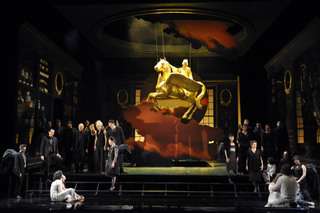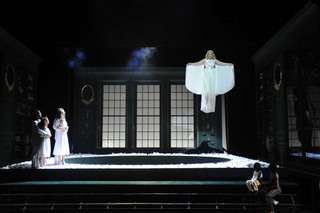|
Back
Cabinet of Wonders New York
BAM Howard Gilman Opera House
03/23/2010 - & 25, 26*, 27 March, 2010
Henry Purcell The Fairy Queen
Emmanuelle De Negri (Night/the Plaint), Lucy Crowe (Juno), Claire Debono (Mystery/Fairy/Nymph/Spring), Miriam Allan, Anna Devin and Maud Gnidzaz (Fairies), Ed Lyon (Adam/Secrecy), Robert Burt (Mopsa), Andrew Foster-Williams (Corridon/Hymen/Sleep/Winter), Sean Clayton (Summer), David Webb (Autumn), Andrew Davies (Phoebus), Helen Jane Howells (Eve)
Non-singing roles: William Gaunt (Theseus), Robert East (Egeus), Alice Haig (Hermia), Nicholas Shaw (Lysander), Gwilym Lee (Demetrius), Joanna Herbert (Helena), Desmond Barrit (Bottom), Amanda Harris (Titania), Jotham Annan (Puck), Finbar Lynch (Oberon)
Les Arts Florissants, Thomas Blunt (Chorus Master), William Christie (Conductor)
Jonathan Kent (Director), Paul Brown (Set and Costume Design), Mark Henderson (Lighting Design), Kim Brandstrup (Choreography)

A. Davies (© Stéphanie Berger)
As the focal point of the first Brooklyn Academy of Music Opera Festival, William Christie and Les Arts Florissants have brought us a delightful production of The Fairy Queen. This joint production of the Glyndebourne Festival Opera, Opéra Comique, Théâtre de Caen, and BAM was first seen at last summer’s Glyndebourne Festival as part of the celebration of the 350th anniversary of Purcell’s birth.
The Fairy Queen is a “semi-opera,” a type of entertainment that was wildly popular in Restoration England. The form integrates text, music, dance and elaborate theatrical effects, and has roots in French Baroque opera as well as in the staged masques famously danced by reigning monarchs, such as Henry VIII and Louis XIV. Rival theater companies competed to produce ever more elaborate “Restoration spectaculars,” driving many theaters into bankruptcy. Purcell’s The Fairy Queen represents one of the few surviving examples of this art form, and its final flowering. It was a huge hit at its premiere in 1692, with magnificent effects including the diversion of water from the Thames to provide flowing fountains. Despite popular success, however, the production could not recover its expenses. The company nearly went bankrupt, and the art form finally collapsed under its own weight.
The production presented at BAM is one of very few to attempt to capture the essence of a full Restoration spectacular, and the sense of wonder it should evoke. Although the overall impression is of a play performed with interludes of dance and song, an interweaving of the elements ultimately forms a gestalt greater than the sum of diverse parts.
The evening began amid a cabinet of curiosities, a private display of natural history and ethnographic collections that was seen as a self-contained microcosm, a universe under control. The major characters are introduced in what is essentially a slightly re-worked version of Shakespeare’s A Midsummer Night’s Dream. The pairs of lovers, Hermia and Lysander, and Demetrius and Helena are Restoration Era nobles. They lay out their romantic woes, Hermia and Lysander determine to elope to the woods, and jealous Helena and Demetrius follow after. Laborers then enter, in modern dress, and perform a comic dance as they clean the room, then depart to the woods to rehearse the play they are preparing for the wedding festivities.
As the last departing laborer yanks out the plug of his vacuum cleaner, there is sudden dark, a flash of sparks, and a thrilling fanfare from the orchestra. The walls pull apart, the floor rises, and the very fabric of reality strains and tears. From under the floorboards and out of the cabinets, black-winged fairies tumble forth, dancing. Their world is introduced to us in music, not in prose.
As worlds collide in the woods at night, the fairies free the lovers from their stuffy costumes, and pinch the laborers until they flee. The fairy Puck gives Bottom the head of an ass, and the familiar story of A Midsummer Night’s Dream unfolds. Under Oberon’s spell, the Fairy Queen Titania falls in love with Bottom, and Puck’s misdirected spell has everyone chasing Helena, with Hermia left forsaken. But by morning, all is put right, and the two couples are united in their chosen love-matches by the approving god of marriage, Hymen, himself.
The masques that interrupt this drama with song and dance are like little jewels from Faerie, and provide a sort of allegorical complement to the action. They rely heavily on clever lighting, smoke, trap doors, lavish props and players flying in and out. When Titania sleeps, she is shrouded in gossamer by her attendants, and then suspended upside down from a spider’s thread. This is a visually compelling scene with an almost hallucinogenic quality. She is attended and beautifully serenaded by figures representing Night, Mystery, Secrecy and Sleep. As Oberon casts his spell on her, an eerie, hissing in the percussion creates a sense of malice and danger. This is the darkest moment of the evening.
After Titania wakes and pursues her affair with Bottom, the next Masque celebrates the arc of love from unrequited desire, to emotional and physical joys, to the sting of infidelity and abandonment. It includes the songs of the Nymph and the comic duet of Mopsa and Coridon. The stage then fills with fluffy white bunnies who indulge in energetic and even acrobatic copulation. Then they peel off their bunny suits and sing “A thousand thousand ways we'll find to entertain the hours.” What we have just seen belies the delicate, innocent grace of the music. This is an excellent example of the juxtaposition of “sublime and graceful lyricism and coarse vulgarity” referred to in interviews by director Jonathan Kent as “quintessentially English.”
After Oberon removes his Spells, we find it is his birthday. The fairies celebrate with song and dance. Then, accompanied by fanfare, clouds descend and part. Phoebus the Sun is revealed flying on his golden steed. Each of the four seasons, outrageously costumed, appears and sings in celebration of the cycle of life. Of special note, bass-baritone Andrew Foster-Williams sang Winter with an impressive lower register, and bone-chilling effect. With a richly colored tone throughout his range, he also sang Sleep, Coridon and Hymen, creating distinct character sketches and displaying superb comic timing with Coridon and Hymen.
Finally, our lovers’ chosen matches receive the seal of official approval. In celebration of the marriages of Hermia and Lysander, and of Demetrius and Helena, the laborers present their hilarious play. Desmond Barrit, as a whimsically Welsh Bottom, is by turns comic and endearing throughout the evening, but he and his troupe of players outdo themselves in this side-splitting funny scene.

L. Crowe (© Stéphanie Berger)
The fairies now crash the party, apparently visible to all. They bring Juno, queen of the gods, who descends from the heavens. Hovering above the stage in angelic white with crystal pleats suggesting wings, she blesses the nuptials singing, “Thrice happy lovers.” Juno was sung by Lucy Crowe with a clear top and fluid legato line. Her tone was first rich and full, then noticeably thinner, showing an exquisite sensitivity to the text.
“The Plaint” immediately follows the wedding hymn and shows the other face of love – that of loss and grief. It was hauntingly rendered here by Emmanuelle de Negri, heard also as Night. Ms. de Negri sang both roles with a warm round tone and darkly colored soprano. Her rendition of “The Plaint” was heartbreaking with its directness and dignity.
After further masques, including Adam and Eve in an allegory of sexual temptation and knowledge, Hymen, god of marriage, is summoned. Fairies and wedding guests enter through the house, singing their invocation, and creating a stunning effect of all-encompassing sound that draws the audience more fully into the scene. Hymen, portrayed with verve by Andrew Foster-Williams comes unwillingly, grumbling about the low quality of love these days. He also enters through the house, pushing his way between the front row and the orchestra pit to cross the stage. Finally convinced, he willingly performs the double wedding. All depart with dance and rejoicing. The fairies vanish back into the cracks in the wainscoting, joining the dusty collections on display. The walls slide back together sealing the gaps, and all becomes normal. All except the newlyweds, now in modern dress. Have they perhaps been changed by their encounter with a magical world that exists just beneath the surface of our own, or simply transfigured by their love?
Jonathan Kent’s production was creative and always lively. The sets by Paul Brown were magically evocative, while William Christie and his superb ensemble captured the beauty and sheer joie de vivre of this work. They were simply dazzling.
Arlene Judith Klotzko
|